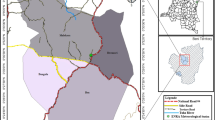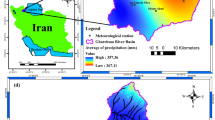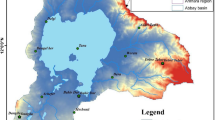Abstract
In order to improve the monitoring accuracy of nuclear power plant thermal discharge, this study takes HongYanHe nuclear power plant as the object to improve the traditional region substitution method with years of HJ-1B/IRS data. After establishment of the optimum similarity measurement by image meshing, the optimum non-discharge grids whose average temperature was taken as the reference temperature were extracted. To evaluate the performance of the new method, results of the new method and other two existing method---water intake method and average bay method were compared and assessed. D-value between reference temperature and background temperature of the new method ranges from −1 to 1 °C. The mean and standard deviation of the absolute D-value of the new method ranges from 0.1 to 0.3 °C. Results suggest that the new method not only achieved better accuracy, but also over comes weakness of the two compared method. It is promising that the new improved method can be extended and applied further in thermal discharge monitoring.










Similar content being viewed by others
References
Aggarwal, C. C. (2001). Re-designing distance functions and distance-based applications for high dimensional data[J]. ACM SIGMOD Record, 30(1), 13–18.
Ahn, Y. H., Shanmugam, P., Lee, J. H., & Kang, Y. Q. (2006). Application of satellite infrared data for mapping of thermal plume contamination in coastal ecosystem of Korea[J]. Marine Environmental Research, 61, 186–201.
Bench-Capon, T. J. M., & Dunne, P. E. (2007). Argumentation in artificial intelligence[J]. Artificial Intelligence, 171, 619–641.
Chen, C., Shi, P., & Mao, Q. (2003). Application of remote sensing techniques for monitoring the thermal pollution of cooling-water discharge from nuclear power plant[J]. Journal of Environmental Science and Health. Part A, Toxic/Hazardous Substances & Environmental Engineering, A38(8), 1659–1668.
Dung, P. M. (1995). On the acceptability of arguments and its fundamental role in nonmonotonic reasoning[J], logic programming and n-Person Games. Artificial Intelligence, 77(2), 321–357.
Hamrick, J. M., & Mills, W. B. (2000). Analysis of water temperature in connoting pond as influenced by the peach bottom atomic power plant thermal discharge[J]. Environmental Science & Policy, 3, 197–209.
Huang, S., & Chen, Q. (2009). Research on high dimensional clustering algorithm based on similarity measure[J]. Microcomputer Information, 25(9–3), 187–188,198.
Liu, Y., & Chen, X. (2011). Suggestion of the study on thermal impact of thermal discharge from NPPs[J]. Radiation Protection Bulletin, 31(6), 20–23.
Mustard, J. F., Carney, M. A., & Sen, A. (1999). The use of satellite data to quantify thermal effluent impacts. Estuarine Coastal and Shelf Science, 49(4), 509–524.
Romero, C. E., & Shan, J. (2005). Development of an artificial neural network-based software for prediction of power plant canal water discharge temperature[J]. Expert Systems with Applications An International Journal, 29(4), 831–838.
Schreiner, S. P., Krebs, T. A., Strebel, D. E., & Brindley, A. (2002). Testing the CORMIX model using thermal plume data from four Maryland power plants[J]. Environmental Modelling & Software, 17(3), 321–331.
Suh, S. W. (2001). A hybrid near-field/far-field thermal discharge model for coastal area[J]. Marine Pollution Bulletin, 43(7–12), 225–233.
Suzhou Nuclear Power Research Institute (2013). Environment impact assessment of unit 3 and 4 in Liaoning HongYanHe nuclear power plant[R].
Tang, D., Kester, D. R., Wang, Z., Lian, J., & Kawamura, H. (2003). AVHRR satellite remote sensing and shipboard measurements of the thermal plume from the Daya Bay, nuclear power station, China[J]. Remote Sensing of Environment, 84(4), 506–515.
Wu, C., Wang, Q., & Yang, Z. (2007). Monitoring heated water pollution of the DayaWan nuclear power plant using TM images[J]. International Journal of Remote Sensing, 28(5), 885–890.
Xie, M., Guo, J., Zhang, H., & Chen, K. (2010). Research on the similarity measurement of high dimensional data[J]. Computer Engineering & Science, 32(5), 92–96.
Yang, F. (2007). Research on technologies for high dimensional data mining[M]. Nanjing: Southeast University Press, 18–19.
Zhu, L. (2013). The remote sensing monitoring of TianWan nuclear power plant thermal discharge based on HJ-1 infrared camera[A]. In: Proceedings of The 17th China environmental remote sensing application technology forum[C], Beijing, 63–67.
Zhu, L., Zhao, L., Wang, Q., Zhang, A., Wu, C., Li, J., & Shi, J. (2014). Monitoring the thermal plume from coastal nuclear power plant using satellite remote sensing data: modeling and validation[J]. Spectroscopy and Spectral Analysis, 34(11), 3079–3084.
Acknowledgments
Thanks are due to Satellite Environment Center, Ministry of Environmental Protection for assistance with the experiments and providing HJ-1B data. This work was supported by the National Natural Science Foundation of China (Grant No.41301388).
Author information
Authors and Affiliations
Corresponding author
About this article
Cite this article
Yin, Y., Zhu, L., Yu, T. et al. The Improvement of Region Substitution Method for Thermal Discharge Monitoring by Remote Sensing Based on Time-Space Series Analysis. J Indian Soc Remote Sens 44, 147–157 (2016). https://doi.org/10.1007/s12524-015-0479-8
Received:
Accepted:
Published:
Issue Date:
DOI: https://doi.org/10.1007/s12524-015-0479-8




